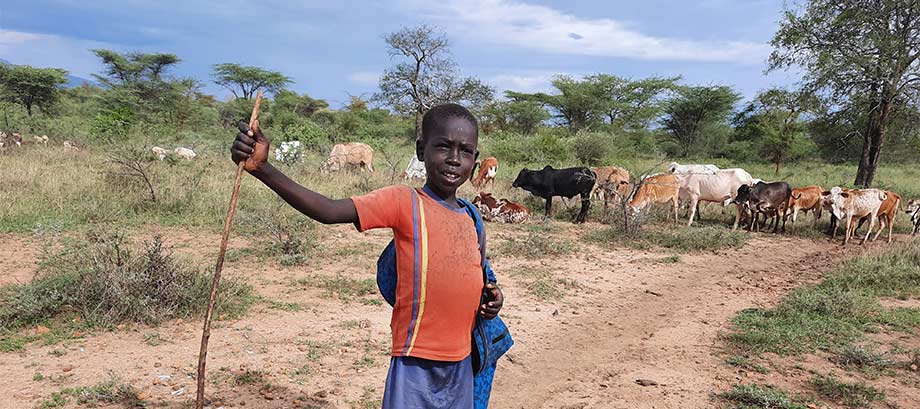Child labour in pastoral communities in Karamoja – an intense experience shaping the future research agenda and influencing recovery
Karamoja is a dry region in the northeastern part of Uganda, bordering Kenya and South Sudan. It is also one of the poorest regions in the country. Its ethnically diverse population lives mainly from nomadic cattle grazing. Cross-border migration and violence have characterized the region over recent decades.
FAO partnered with the Economic Policy Research Center (EPRC) to investigate child labour in pastoral communities throughout Karamoja. The purpose of the study was to understand the prevalence of child labour among pastoralist communities and its main drivers. The team interviewed local district officials, local NGOs, the local government, education officers and community members, including boys and girls of different age cohorts and their guardians.
Francis Mwesigye, a Senior Research Fellow with EPRC, led one of the two research teams to collect data across the nine districts of Karamoja in October 2020. He reported that, “despite our long research experience in the Karamoja, the study was an eye-opener for us. The most striking aspect was that sociocultural norms are much more prominent than what we thought and influence how parents perceive child labour.”
EPRC found that child labour is common among pastoral communities and that kids as young as 7 years are asked to graze cattle far away from home until late at night. An issue that seemed to worry communities was the resurgence of cattle raids over the last year. Learning to defend the cattle, including through having to use sharp weapons, is common practice. Mr Mwesigye added that “defending the cattle from raiders is considered by parents and community members as a sort of initiation rite to prove sense of responsibility and adulthood. Kids, and other youth in general, are also praised for killing potential raiders.”
When looking at child labour among girls, the pictures was no more optimistic: severe forms of child labour, such as the trafficking of young girls, is very common. With the spread of COVID-19 and associated school closures, EPRC has witnessed an increase in domestic violence, early pregnancy and child marriage, which includes girls as young as 13 years. According to Mr Mwesigye, “Even when schools will reopen, many kids may not go back to school”.
At the time of the field work, the EPRC team was also involved in the review of the “Third Peace, Recovery and Development Plan (PRDP 3),” a programme implemented by the office of the Prime Minister in Northern Uganda, through which Karamoja is a beneficiary. The FAO-EPRC study provided grounds to include key aspects of access to education and training into PRDP 3.
EPRC was motivated by this study to generate more evidence that can inform interventions to end child labour and promote child education in Karamoja. One of the next steps will be to facilitate the dissemination of the study findings with policy makers in collaboration with authorities in the region.
Programme
4. Generational gaps, women empowerment and decent rural employment
Subprogramme
Generational gaps and eliminating child labour in agriculture
(FMM/GLO/137/MUL)
Share this page

